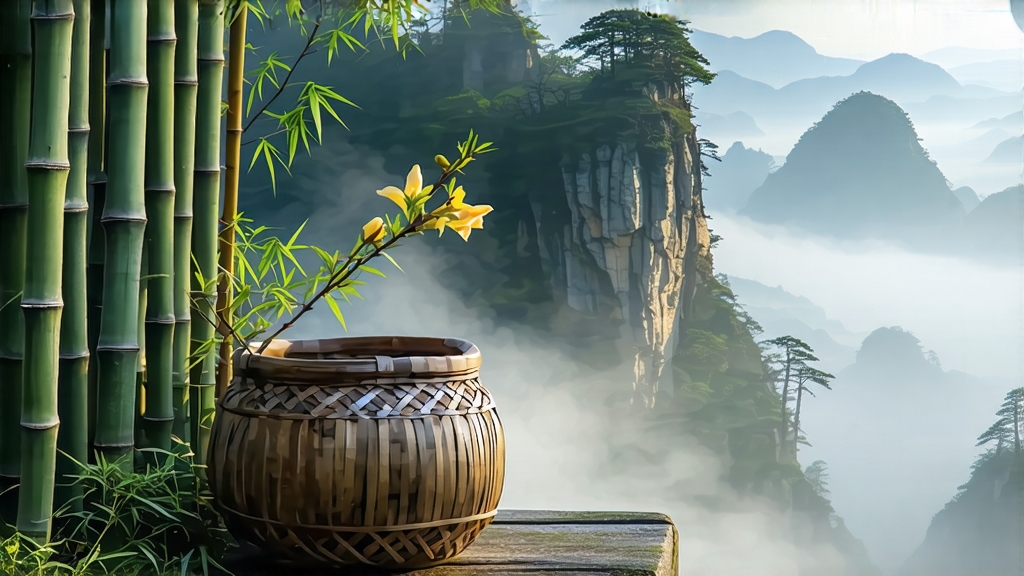
Tucked high on the mist-locked ridges of Meng Ding Mountain in Sichuan Province, Meng Ding Huang Ya—literally “Meng Ding Yellow Bud”—has been whispered about in Chinese tea texts for more than twelve centuries. Unlike the better-known green teas that surround it geographically, this yellow tea survives only in a handful of micro-gardens perched between 800 m and 1 400 m, where perennial cloud cover slows photosynthesis and concentrates amino acids in the tiny spring buds. The result is a liquor so softly sweet and layered that Song-dynasty poets once christened it “the imperial dew,” a tribute later made literal when Tang-era tribute lists reserved the entire crop for the palace. Today the annual yield is still measured not in tons but in tens of kilos, making authentic Meng Ding Huang Ya one of the rarest authenticated styles in the vast Chinese tea canon.
What turns a green tea into a yellow tea is not geography alone but a meticulous extra step known men huan—“sealed yellowing.” After the kill-green wok roast arrests oxidation, the still-warm leaf is wrapped in thick paper or steamed cloth and left to suffocate in its own residual moisture. Over roughly 48 hours the chlorophyll gently degrades, carotenoids intensify, and a whisper of non-enzymatic oxidation softens the grassy edges normally associated with early-harvest green teas. The cycle of roasting and re-wrapping may be repeated three to five times, each iteration reducing the leaf’s water content by only a few percentage points so that the buds remain straight and silvery while their inner chemistry drifts toward a warmer hue. When the master finally decides the leaf has “turned yellow enough,” the buds are given a low-temperature bake to lock in fragrance; any further delay would tip the tea into light oolong territory, so the decision is measured in minutes and signaled by an almost subliminal scent of toasted pumpkin.
Plucking standards are draconian: only the single unopened bud, or at most bud-and-half-open-leaf, picked before Qingming festival when dawn mist still beads on the tea bushes. A skilled picker gathers barely 250 g of fresh material per hour; five kilos of bud are required to yield one kilo of finished tea, which partly explains the price that can rival top-grade Longjing. Once picked, the buds are never piled deeply; they are carried in shallow bamboo trays to the village workshop within two hours so that cellular respiration does not generate unwanted heat.
The crafting sequence unfolds like choreography. First, a high-heat “flash kill” in iron woks held at 160 °C for three minutes deactivates polyphenol oxidase while preserving the downy hairs that give yellow tea its velvety tactile appeal. Next comes the first rudimentary rolling—just enough to break surface cell walls and release aromatic precursors, yet gentle enough to keep the bud intact. The leaf is then swaddled in handmade mulberry paper and placed in a wooden warming chest kept at 28 °C and 75 % relative humidity. During the next two days the master unwraps the bundles every six hours to aerate and re-roast, judging readiness by the colour shift from jade to pale primrose and by the emergence of a scent that Chinese cuppers describe as “chestnut beneath rain.” The final bake drops the moisture to 5 %, low enough for shelf stability yet high enough to preserve the enzymatic sweetness that will bloom in the cup.
Western drinkers often confuse yellow tea with lightly oxidised oolong or aged white tea; the tell-tale difference lies in the steeped leaf. After five infusions a Meng Ding Huang Ya bud will rehydrate into a perfect tiny spear, its tip still closed, the margins unbroken, but the colour an even old-ivory. The liquor itself is the colour of antique chardonnay, bright yet somehow viscous, releasing aromas that oscillate between fresh corn silk, steamed Japanese kabocha, and a distant floral note closer to daphne than to jasmine. On the palate the tea enters without astringency, coats the tongue with a glycerine smoothness, and finishes with a cooling sensation in the throat that Chinese texts call sheng jin—“the birth of fluid.” Professional cuppers score the best lots 98+ on the China National Tea Standard, deducting points only for the faintest trace of vegetal sharpness that occasionally survives the yellowing.
To brew Meng Ding Huang Ya respectfully, use soft water at 85 °C and a tall cylindrical